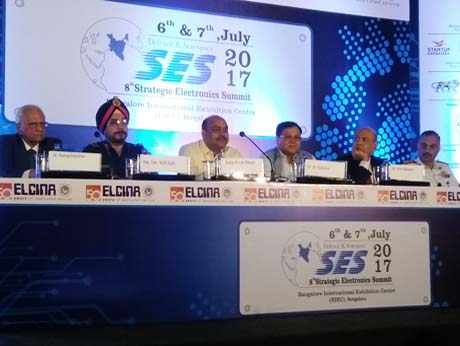
Bangalore, July 9 2017: India is the world's largest importer of military equipment. Indigenous manufacture and procurement accounts of a small fraction of the country's strategic requirement -- inspite of having in place, a large defence R&D organisation and a mature electronics industry.
The irony of this situation -- Space and Atomic Energy unlike the defence sector, meet most of their requirements through local procurement -- ran as a continuing threads over two days of discussion and debate at the 8th annual Strategic Electronics Summit organised by ELCINA, the nodal association of the electronics hardware industry in India, held in Bangalore last week.
In his keynote address, V K Saraswat, Member, Niti Aayog, former missile scientist and head of the Defence R&D Organisation (DRDO), minced no words: "In our quest to get the best global technology, we end up importing ready products. This is detrimental to growing local capabilities as import is the easy way out".
When it comes to indigenously developed weapon systems, he hinted to an audience, which included defence services top brass, that when they examine " the fine granularity of specifications" for every major weapon, in their quest for the best, they are not helping to build Indian capability based on growth. In pleading that time was the criterion when they opted for the import path for systems like the Naval version of the Light Combat Aircraft (LCA), the uniformed services were in fact perpetuating a Catch 22 situation he suggested.
Dr Saraswat added. " We should not adopt a holier than thou attitude" when it comes to the free market economy and throttle the indigenous industry in the process.
The Preferred Market Access (PMA) policy has failed to deliver desired results because it only addresses the demand from Central Government ministries. It does not include state governments and PSUs, MTNL, BSNL and major public projects. " North and South Block cannot be the only customers", Dr Saraswat said. In addition the local manufacturer is expected to meet impractical requirements of tenders and after he has invested heavily to meet a small order, he is then required all over again to compete again in a global tender.
Rear Admiral Atul Khanna, the Navy's Assistant Chief of Material, said Naval shipbuilding had become completely indigenous -- but the equipment on board fighting vessels was less so. There were three categories of ship borne equipment: Float-Move-Fight, ie the elements like the hull and structure that kept the vessel afloat, propulsion and other elements that helped it sail and the weaponry used to provide fighting power. While 80%-90% of float elements were indigenous and 40% - 50% of sail elements, Indian warships still used only. 30% to 40% indigenoyus weapon systems, he added. This was a matter of concern -- since at a time of conflict, the embedded systems that lay at the heart of the imported weapons were susceptible to hack attacks from outside.
He however drew the attention of small and medium industry to the low hanging fruit -- the opportunity to provide life time support and spares for imported systems through reverse engineering.
Maj.General M.J.S. Syali, Additional Director General, Electrical and Mechanical Engineers, for the Army, said a similar opportunity for SMEs was provided by the Army. In fact many such Indian players were providing not just sub assemblies but entire systems to Army workshops. He gave as an example the BMP armoured amphibious tracked infantry fighting vehicle, originally of Russian origin, and now manufactured in India.
Mr Sanjay Kumar Rakesh, Joint Secretary in the Union Ministry of Electronics and Information Technology ( MEITY) pointed at the National Policy for Electronics first issued in 2012 and said many lacunae were being addressed thanks to feedback from the industry. Indian industry was at a 'competitive disadvantage', in three crucial areas: power, finance and infrastructure, he said.
Commenting on the industry readiness vis-à-vis the emerging market opportunity Mr. Rajoo Goel, Secretary General, ELCINA said: “With the announcement of Defence Procurement Procedure 2016 and the Strategic Partnership Programme by the Government, the India Electronics industry stands to gain a lot in terms of value added manufacturing opportunities, skill upgradation and employment generation. Success however would depend on effective implementation and clear guidelines of engaging Development Partners who would largely be the MSMEs.”
---------------------------------------------------------------------------------------------------------------------------------------------------------------------------------------------
Strategic Electronis: a Rs 10 billion opportunity
Requirement for Combat Systems and non-platform based defence Strategic Electronics for India is pegged at Rs. 100,000 crore ( Rs 10 billion) for the five year period ending 2017; between 2016-25 defence contracts worth US$ 75 billion are expected to come up in India, representing a potentially very large opportunity for the electronics industry.
The ‘Report of the Working Group on Defence Equipment’, estimates Defence Electronics at Rs. 25,700 crore. This amounts to about 25% of the capital expenditure projections of the working group in 2016-17.
---------------------------------------------------------------------------------------------------------------------------------------------------------------------------------------------